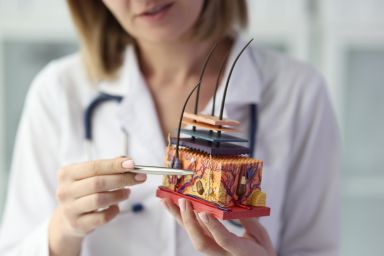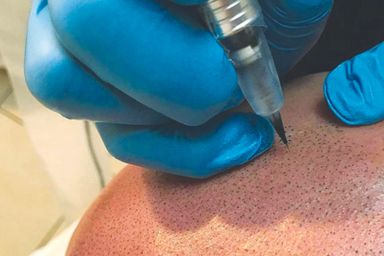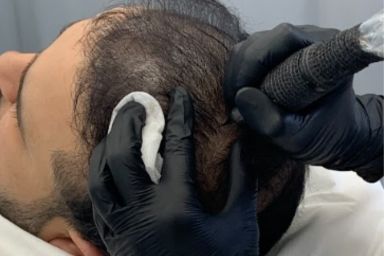Established for over 25 years
Clinics Nationwide
5 Star Google & Trustpilot Reviews
Female Temple Hair Loss: Causes, Prevention & Treatment

Reading time: 8 min
Female Temple Hair Loss: Understanding the Causes and Finding Solutions
While male pattern baldness receives significant attention, female hair loss often remains shrouded in mystery. The reality is that hair thinning and loss affect both genders, and women experiencing temple hair loss deserve just as much understanding and support.
This article delves into the root causes of temple hair loss in women, empowering you with knowledge and practical strategies. We'll explore the underlying factors, equip you with effective prevention methods, and navigate the various treatment options available.
Key Takeaways
- Temple hair loss is a common concern for women, affecting both hair density and the hairline.
- Various factors contribute, including genetics, hormones, and lifestyle habits.
- Early detection and understanding the cause are crucial for effective management.
- Preventive measures like gentle hair care, balanced diet, and stress management can help.
- Treatment options range from medications and minimally invasive procedures like Scalp Micropigmentation For Women, to hair transplants.
- Consulting a healthcare professional for diagnosis and personalised treatment is recommended.
Table of Content

Temple hair loss manifests as thinning hair and a receding hairline at the temples. It's often linked to female pattern baldness, but other types like telogen effluvium, traction alopecia, and frontal fibrosing alopecia can also affect the temples. Recognizing these variations is crucial for effective treatment.
Identifying Signs of Temple Hair Loss
Temple hair loss can manifest in various ways, making early detection crucial. Here are some key signs to watch for:
- Thinning hair: Noticeable decrease in hair density around the temples, often starting subtly.
- Receding hairline: This can progress into an "M" shape for men, while women may experience a more diffuse thinning across the hairline.
- Bald patches: In advanced cases, thinning can progress to visible patches of baldness at the temples.
By recognising these signs early, you can seek prompt diagnosis and treatment to address temple hair loss effectively.

Image showing a tight hairstyle that can cause temple hair loss through Traction Alopecia
Temple hair loss can stem from various factors, categorised into hormonal/genetic and lifestyle influences:
- Androgenetic Alopecia: Also known as female pattern loss, is a common condition, linked to both hormones and genetics, disrupts hair growth and can cause overall thinning, including at the temples.
- Traction Alopecia: Tight hairstyles like ponytails or braids can cause this type of hair loss due to prolonged tension on hair follicles. Early detection and avoiding such styles can often reverse it.
Other hair loss types like frontal fibrosing alopecia, alopecia areata, telogen effluvium, PCOS-related hair loss, and postpartum hair loss can also affect the temples, but understanding the two main categories above provides a good starting point.
Understanding the causes of hair loss is essential, but prevention can play a crucial role. Here are key strategies:
Gentle Hair Care:
- Minimize breakage and scalp irritation by avoiding tight hairstyles, harsh treatments, and excessive heat styling.
- Opt for loose styles, gentle products, and regular washing with mild shampoo and conditioner.
Nutritional Support:
- Nourish your hair with a balanced diet rich in iron, protein and biotin, all vital for healthy hair growth.
- Consult a healthcare professional before starting hair supplements.
Stress Management:

Yoga being performed to help with stress management
Chronic stress can disrupt hair growth. Practice relaxation techniques like meditation, deep breathing, yoga, or regular exercise to manage stress and promote overall well-being.
While prevention is ideal, advanced solutions exist for significant hair loss:
Medications:
- Minoxidil: Topical treatment stimulating hair growth and slowing loss.
- Finasteride: Oral medication preventing conversion of testosterone to DHT, which can shrink hair follicles.
Consult a healthcare professional before starting any medication due to potential side effects.
Other Treatments:
- Hair Loss Microneedling: Creates controlled scalp injuries to potentially stimulate hair follicles.
- PRP & Mesotherapy: Injections deliver nutrients to encourage hair growth.
- Low Level Laser Therapy: Uses light therapy to promote healthy hair growth.
- Scalp Micropigmentation (SMP): Creates the appearance of hair follicles, offering density and fullness.

A Scalp Micropigmentation treatment being performed
Hair Transplants:
- Follicular Unit Extraction (FUE): Surgical technique where individual hair follicles are extracted from the donor area and transplanted to the balding areas. Offers minimal scarring and discomfort, making it a popular choice compared to FUT Transplants.
- Follicular Unit Transplantation (FUT): Surgical technique where a strip of scalp is removed from the donor area, dissected into individual grafts, and transplanted to the balding areas. Offers a quicker procedure but may leave a linear scar at the donor site.
Additional Considerations:
- Each treatment has its own benefits, risks, and suitability for different individuals.
- Combining treatments may be recommended for optimal results.
- Consider factors like cost, recovery time, and desired outcome when making a decision.
While taking proactive steps to manage hair loss is commendable, consulting a healthcare professional is crucial in certain situations. Here's when to seek expert advice:
- Premature balding: Noticeable hair loss at a young age.
- Increased shedding: Experiencing significantly more hair fall than usual.
- Significant hair thinning: Observable scalp showing through previously dense hair areas.
Why consult a professional?
- Expertise in diagnosis: Dermatologists, trichologists, and hair transplant surgeons can accurately diagnose the cause of your hair loss.
- Tailored treatment plans: They recommend personalised treatment options based on the underlying cause and your specific needs.
- Comprehensive evaluation: They may conduct tests like blood work to rule out any underlying medical conditions contributing to hair loss.
Remember, early intervention is key. Consulting a professional promptly allows for a timely diagnosis and appropriate treatment plan, maximizing your chances of successful hair loss management.
Summary
While often overshadowed by male pattern baldness, female temple hair loss is a prevalent concern. This article sheds light on the causes, signs, and management strategies for this condition. Understanding the different types of hair loss, their underlying factors, and preventive measures empowers women to take control of their hair health. Exploring various treatment options, from medications to surgical procedures, provides a comprehensive overview of available solutions. Remember, seeking professional guidance is crucial for accurate diagnosis and personalised treatment plans, maximizing your chances of successfully addressing temple hair loss and regaining confidence in your hair's appearance.
Is temple hair loss in women permanent?
It depends on the cause. Androgenetic alopecia can be progressive, but early intervention and treatment can slow or even reverse hair loss. Other causes like traction alopecia may be reversible if the hairstyling practices are changed.
Are there any hairstyles that can help hide temple hair loss?
Hairstyles with volume at the crown and bangs that sweep across the forehead can help conceal thinning hair at the temples. However, avoid tight hairstyles that can worsen hair loss.
Can I wear extensions if I have temple hair loss?
Extensions can put additional stress on the hair follicles, potentially worsening temple hair loss. Consult a trichologist or hair loss specialist before using extensions.
Does menopause contribute to temple hair loss?
Hormonal fluctuations during menopause can sometimes lead to temporary hair thinning, but it's not a guaranteed occurrence for all women.


Article author Dawn Forshaw — Published on 1st March 2024

Does Scalp Micropigmentation Damage Hair Follicles?

Scalp Micropigmentation: A Solution for Blonde & Fair Hair (Men & Women)

Can You Use Minoxidil with Scalp Micropigmentation?

Is Scalp Micropigmentation Permanent?

Paul's Transformation: Navigating Alopecia Universalis with Eyebrow & Scalp Micropigmentation

Scalp Micropigmentation Fading: A Comprehensive Guide

Eyebrow Hair Loss Demystified: Uncovering Causes and Pursuing Solutions

Botched Scalp Micropigmentation Treatment: What Are Your Options?

Combining Scalp Micropigmentation and Hair Transplants: The Ultimate Hair Loss Solution
- Choosing a selection results in a full page refresh.
- Press the space key then arrow keys to make a selection.

